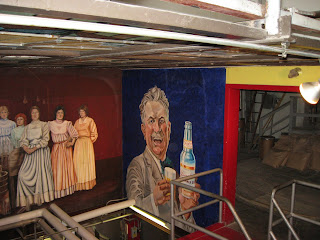
Pioneer Tunnel is a horizontal drift mine that goes 1800 feet into the side of the Mahanoy mountain. For a small fee, you can get an educated tour of the mine yourself. You’ll ride in an open mine car that runs on a battery-operated motor. Your guide will even be a miner himself, or a retired one. During the 35-minute tour, you’ll learn how coal is mined from underground. You’ll see large coal seams where the mining was done and even portions of a petrified tree, most of which is displayed in the Smithsonian.
At one point during the tour, you’ll even see nothing as they turn all the lights out to show you how dark it really is in there. You literally can’t see your hand in front of your face. Not to be alarmed, they turn the lights back on. They’ll show you some replicas of mining tools past used, such as dynamite and canary birds.

The Pioneer Tunnel was an active coal mine in the early 1900’s. It ceased operations in 1931. In May of 1963, the mine was opened to the public. The mine is inspected daily by a mining foreman and 100% safe, although chilly with its year-round temperature of 52 degrees.
While there, you can also ride on the Henry Clay. This is an old time locomotive, built in 1927. It’s one of the oldest running steam locomotives. It was used to haul coal from the strip mines. While on the tour, you’ll learn more about strip mining as well as see an abnormally thick seam of anthracite known as the “Mammoth Vein.” Steam shovels pulled millions of tons of coal from the area leaving a wall of solid rock 150 feet high and as far westward as you can see. You’ll also notice a relic of a bootleg coal hole. Those who were willing to defy trespassing laws and risk cave-ins would brave the mines so they could heat their homes.
The train ride is ¾ of a mile long and goes around the Mahanoy mountain, giving you some scenic glimpses of the town of Ashland below you. Outta the Way recommends the visit even though there is a fee. You too, will find why it is consistently voted as one of the top 10 spots to visit in PA.



















